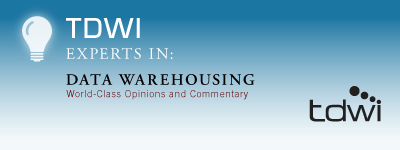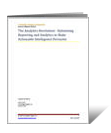Rather than operate in an unconstrained and uncoordinated environment, most organizations have rightly established enterprise standards relative to the products and technology they deploy in their data warehousing environments. These standards help ensure consistency in development, operations, and systems integration, and they help reduce training and staff recruitment costs and serve to limit the number of vendors that an organization has to deal with. Many of these standards are directed at database and business intelligence offerings.
I am in agreement with the need for standards and appreciate the resulting benefits. However, I am concerned that some organizations may be applying them so absolutely that they prevent themselves from experimenting with new technologies that might be appropriate in specific situations today -- and potentially many more situations in the future.
Although an organization may have established an enterprise standard of using IBM DB2, Microsoft SQL Server, or Oracle as its data warehouse database, a data warehouse appliance based on alternative database technology might be well-suited to a specific analytical application such as fraud detection, customer churn prevention, Web traffic analysis, or text and data mining.
After all, if organizations strictly enforced early database technology standards, the database world still revolve around flat files. Hierarchical, Codasyl, inverted list, multi-value, relational, object-oriented, value-based storage, and columnar-relational architectures and data structures would only be of academic interest.
A Hybrid Example
Consider the choice of business intelligence tools. Even if an organization has an absolute standard relative to their data warehouse database technology, this does not necessarily prevent multiple tools from different vendors from being used to analyze the data in the database. I have noticed that even when organizations have standardized on a limited number of business intelligence tools, these standards often only apply to new development activities. BI tools already in use tend to be grandfathered in for existing applications. Additionally, when developers insist that a tool that does not confirm with the enterprise standard is the most appropriate choice, its use is oftentimes still permitted.
Enterprise Standards versus Departmental/Functional Needs
It is also important to consider if an enterprise standard must truly be applied across the entire enterprise! Although it may, by definition, appear that it should, it may be desirable to establish policies that allow non-standard technology to be deployed in applications whose usage is limited to a single department or functional area. I believe that at the very least, exceptions could be granted for applications that are intended for one-time limited use such as special reports and analyses.
However, as most of us have experienced, supposedly one-time applications sometimes evolve into regularly scheduled reports. Consequently, deployment of these one-time applications must be monitored and, if they become part of the regular production report cycle, may need to be modified to use tools that conform to the enterprise standards. Another, perhaps more pragmatic approach would be to add the non-standard, but now proven, technology or product to the approved list.
Rather than blindly conforming to standards, forward-looking organizations should encourage their members to experiment with alternate technologies, perhaps in an "analytic sandbox" or test environment, in order to discover and identify those that will help them improve their effectiveness and efficiency.
The bottom line is that although standards are desirable and beneficial, they should not necessarily be absolutely enforced or become so restrictive that they discourage the investigation of new technologies. After all, today's innovative and cutting-edge product might just become tomorrow's accepted technology, and companies that have acquired early expertise will almost certainly be at a competitive advantage.
Michael A. Schiff is a principal consultant for MAS Strategies. He can be reached at [email protected]
Related Resources
White Papers:
Webinars:

Using Predictions to Power the Business
May 4, 2010
Speaker: Wayne Eckerson

BI on a Limited or Shrinking Budget: Strategies for Doing More with Less
July 7, 2010
Speaker: Wayne Eckerson





